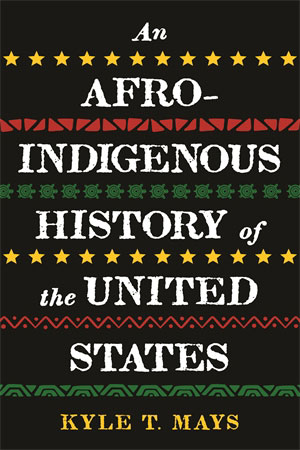The Book
An Afro-Indigenous History of the United States
The Author(s)
Kyle T. Mays

The goal of Beacon’s popular “ReVisioning American History” series is to “offer fresh perspectives of familiar narratives… told from the viewpoint of underrepresented communities,” and Kyle Mays’s An Afro-Indigenous History of the United States aptly fulfills that mission. Mays, an Afro-Saginaw Chippewa scholar at UCLA, reveals his personal and intellectual motivations for writing this fascinating book, which stem from his endemic curiosity about his ancestral roots and a simmering outrage at the lack of scholarly attention to the intersections of black and indigenous histories. Frustrated by personal and academic silos, which often separate black and indigenous identities and histories, Mays argues that “the twin oppressions of antiblackness and settler colonialism have been a central site through which racial and gender formations have occurred in the United States.” Furthermore, he is not content with exploring common oppression caused by the forces of white supremacy but also aims to illustrate “how Black and Indigenous peoples…have sought solidarity with each other.”[1] Mays successfully proves his layered argument on several accounts, but he falls short on others, which leaves the topic ripe for further exploration.
Rather than offering a seamless narrative of Afro-indigenous history, Mays drops the reader into key moments in American history, identifying pieces of famous historical episodes that have been ignored by most scholars and certainly by the American public. For example, in his retelling of the U.S. Supreme Court’s Dred Scott decision in 1857, he highlights Judge Taney’s willingness to consider Native American’s potential for “civilization” and thus inclusion in the United States citizenry, while simultaneously positing African Americans’ inherent inability to gain citizenship because of their legal status as property. Similarly, at the Universal Races Congress in London in 1911, he notes that indigenous leader Charles Eastman (Santee Dakota) and W.E.B. Du Bois both attended the event as advocates for their people and embraced a shared future that “could usher in a new, democratic society, one based upon social, political, and economic inclusion, not white supremacy.”[2] Eastman’s and DuBois’s attendance at the URC illustrates a potential weakness of the argument, however, and Mays is refreshingly honest about the fact that no one knows if Eastman and Du Bois “were able to chop it up” (meet), or even read/discuss the papers each presented at this conference. Mays’s conversational style is refreshing, but his attempt to bring together black and indigenous histories is more theoretical than actual prior to the mid-20th century.
His best evidence comes from his analysis of Black Power and Red Power and the ways in which leaders of these radical fights for justice recognized the interrelated nature of black and Indian oppression. Mays draws parallels between Malcolm X’s emphasis on the importance of black land ownership with indigenous claims of sovereignty, but he rightly acknowledges that “Malcolm’s conception of land is diametrically opposed to Indigenous people’s conception of land.”[3] Malcolm wanted property, a source of black wealth and independence, whereas Native Americans conceived of an ancestral and spiritual connection to the land in addition to wanting sovereignty over it. That said, Black Power and AIM activists sometimes joined forces in their quests for justice, as best illustrated by Stokely Carmichael and Angela Davis supporting the Wounded Knee protest in 1973. In addition, he reveals how black activists in this century have challenged anti-indigenous, racist mascots, noting how ESPN’s Bomani Jones wore his controversial “Caucasian” T-shirt during a broadcast to raise awareness about the inherent offensiveness of Cleveland’s mascot.
Mays concludes his study by contemplating “Possibilities for Afro-Indigenous Futures.” Ultimately, I think Mays’s solution for black and indigenous liberation is sound if incomplete; he claims, “We cannot get rid of racism without also uprooting its capitalist base. The modern capitalist system is based upon the exploitation of Black and Brown people around the globe.”[4] To that I would add that we cannot get rid of racism without also challenging patriarchy, but Mays curiously leaves this piece of the puzzle (mostly) out of the picture. He lifts up important black and Indigenous feminists on occasion, for example noting Fannie Lou Hamer’s crucial role in the Civil Rights Movement, but tackling patriarchy and misogyny along with white supremacy does not figure into his systemic analysis of the past or of future possibilities. Given how central gender roles are to understanding black and indigenous points of collaboration and conflict (see “old school” books like Kathleen Brown’s Goodwives, Nasty Wenches and Anxious Patriarchs and new scholarship like Kathleen Belew and Ramon Gutierrez’s A Field Guide to White Supremacy), this oversight is unfortunate, but it opens the door for further scholars to pursue the exciting and still understudied field of Afro-Indigenous history.
[1] Kyle T. Mays, An Afro-Indigenous History of the United States (Boston: Beacon Press, 2021), xxi.
[2] Mays, An Afro-Indigenous History, 74.
[3] Mays, An Afro-Indigenous History, 92.
[4] Mays, An Afro-Indigenous History, 179.
About the Reviewer
Kristen T. Oertel is the Mary F. Barnard Professor of History at the University of Tulsa. Her first book, Bleeding Borders: Race, Gender, and Violence in Pre-Civil War Kansas, examines how Native Americans, African Americans, and gender shaped the conflict over slavery immediately before the Civil War. Oertel’s most recent book, Harriet Tubman: Slavery, the Civil War, and Civil Rights in the 19th Century, chronicles the life of this iconic leader of the Underground Railroad and provides a scholarly, yet accessible account of her life for college students and the adult reading public.

0